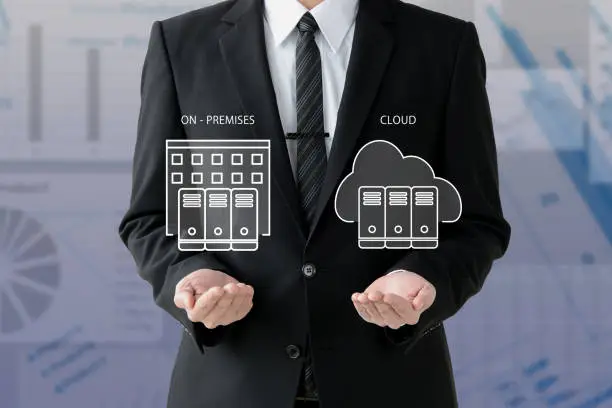Introduction to Cloud and On-Premise IT
What is Cloud Computing?
Cloud computing is like renting a ready-to-go office in the digital world instead of building your own physical building. It allows businesses to access computing resources—like servers, storage, and applications—over the internet, managed by providers such as Amazon Web Services (AWS), Microsoft Azure, or Google Cloud. Instead of buying and maintaining physical hardware, you tap into a shared infrastructure hosted elsewhere.
What is On-Premise IT?
On-premise IT is the traditional setup where companies own and maintain their own physical servers and IT infrastructure within their premises. It’s like owning your own office building, with full responsibility for upkeep, security, and upgrades. This model gives organizations full control over their systems but demands substantial investment and expertise.
Key Differences Between Cloud and On-Premise IT
Infrastructure Ownership
Cloud: Infrastructure is owned and managed by third-party providers.
On-Premise: Infrastructure is owned and managed by the organization.
Deployment Models
Cloud computing typically uses multi-tenant architectures, where resources are shared among many users. On-premise systems are single-tenant, exclusive to one organization.
Pros of Cloud IT
Scalability and Flexibility
Cloud IT lets you scale your resources up or down instantly. Need more storage during peak seasons? Just a few clicks and you’re set. This flexibility is unmatched in on-premise setups, where hardware upgrades take time and money.
Cost Efficiency
Pay-as-you-go pricing means you only pay for what you use. No huge upfront costs for hardware, power, or cooling. This is why startups love cloud services—it’s a budget-friendly way to get enterprise-level power.
Accessibility and Collaboration
Cloud enables your team to access applications and data anytime, anywhere—perfect for remote work or global teams. Collaboration tools like Microsoft 365 and Google Workspace thrive on cloud platforms.
Automatic Updates and Maintenance
Cloud providers handle all the heavy lifting when it comes to software updates, patches, and security. This reduces your IT team’s burden and ensures you’re always running the latest software.
Cons of Cloud IT
Security and Compliance Concerns
Although cloud providers invest heavily in security, some businesses worry about trusting third parties with sensitive data. Compliance with industry-specific regulations like HIPAA or GDPR can also be tricky in the cloud.
Dependence on Internet Connectivity
Without a stable internet connection, cloud access can grind to a halt. This dependence can be a major drawback in locations with unreliable connectivity.
Potential for Hidden Costs
While cloud can be cost-effective, unexpected fees for bandwidth, data transfers, or premium support plans can add up if not monitored carefully.
Pros of On-Premise IT
Complete Control Over Infrastructure
Owning your hardware means you call all the shots. You can configure systems exactly how you want and manage data flows with no middlemen.
Enhanced Security for Sensitive Data
For highly sensitive information, such as government or financial data, on-premise solutions provide physical isolation and stricter control which some companies prefer for compliance reasons.
Customization and Integration
On-premise IT allows deep customization and easy integration with legacy systems, which can be vital for companies with unique workflows.
Cons of On-Premise IT
High Initial Capital Expenditure
Buying servers, storage devices, and networking gear requires a big upfront investment. Plus, there are ongoing costs for electricity, cooling, and physical space.
Maintenance and Upkeep Responsibility
Your IT team must handle hardware failures, software updates, backups, and security—tasks that are automated or outsourced in the cloud.
Limited Scalability
Scaling means physically buying and installing new hardware, which can be slow and expensive. This lack of agility can hamper business growth or adaptation.
Cost Comparison: Cloud vs. On-Premise
Capital Expenditure (CapEx) vs. Operating Expenditure (OpEx)
On-premise involves CapEx — upfront spending on physical assets. Cloud relies on OpEx — ongoing subscription fees. For many businesses, OpEx models provide more financial flexibility.
Long-Term Cost Considerations
While cloud seems cheaper initially, over time, costs might exceed those of on-premise due to recurring fees, especially for stable workloads.
Security Considerations
Cloud Security Best Practices
Cloud providers follow strict security protocols, including encryption, identity management, and multi-factor authentication. Yet, organizations must also manage their own access controls and data governance.
On-Premise Security Measures
On-premise security depends heavily on the company’s internal policies, physical security controls, and IT expertise. This can be a double-edged sword: total control but higher risk if not managed well.
Performance and Reliability
Cloud Service Uptime Guarantees
Major cloud providers boast uptime of 99.9% or higher, backed by Service Level Agreements (SLAs). Still, outages happen and can impact business.
On-Premise System Reliability
With on-premise, your uptime depends on your hardware quality and IT team’s skills. While outages might be less public, recovery could take longer without external support.
Compliance and Regulatory Factors
Cloud Compliance Certifications
AWS, Azure, and Google Cloud hold certifications for HIPAA, GDPR, PCI-DSS, and more. However, you must ensure your cloud configuration meets compliance needs.
On-Premise Compliance Control
On-premise deployments offer direct control to implement compliance policies, audits, and data residency requirements but require strong internal governance.
Use Cases: When to Choose Cloud IT
Startups and Small Businesses
Cloud allows these companies to access powerful resources without heavy upfront costs. They can quickly pivot and grow without IT bottlenecks.
Dynamic Workforces and Remote Teams
Cloud’s accessibility and collaboration features make it ideal for companies with distributed teams or flexible work policies.
Use Cases: When to Choose On-Premise IT
Large Enterprises with Legacy Systems
Companies with extensive legacy infrastructure may find on-premise more compatible and cost-effective in the long run.
Highly Regulated Industries
Sectors like banking, healthcare, and government often require on-premise setups to meet strict data protection laws.
Hybrid Solutions: The Best of Both Worlds
What is Hybrid IT?
Hybrid IT blends cloud and on-premise systems, allowing organizations to optimize workloads based on cost, security, or performance.
Benefits and Challenges of Hybrid IT
Hybrid models offer flexibility but increase complexity in management and integration.
Future Trends in Cloud and On-Premise IT
Edge Computing
Processing data closer to where it’s generated helps reduce latency—especially important in IoT and real-time applications.
Increasing Cloud Adoption
Despite on-premise advantages, cloud adoption continues to grow, driven by AI, big data, and digital transformation initiatives.
Conclusion: Choosing the Right IT Infrastructure
Choosing between cloud and on-premise IT is not a one-size-fits-all decision. It depends on your business needs, budget, security requirements, and future goals. For many, a hybrid approach might be the sweet spot—leveraging cloud flexibility while maintaining control where it matters most.
FAQs
1. Is cloud computing more secure than on-premise IT?
Cloud providers invest heavily in security, but ultimate protection depends on proper configuration and shared responsibility. On-premise can be more secure if managed well but is riskier if not.
2. Can small businesses afford on-premise IT?
Typically, on-premise requires significant upfront costs and IT expertise, making cloud more suitable for small businesses.
3. What are the hidden costs of cloud IT?
Costs can include data transfer fees, premium support, and unexpected usage spikes, which can add up if not monitored.
4. How does hybrid IT work?
Hybrid IT integrates both cloud and on-premise environments, allowing workloads to run where they are most efficient and secure.
5. Will on-premise IT become obsolete?
Not anytime soon. While cloud grows, many industries still rely on on-premise for compliance, control, and legacy integration.
If you want to explore cloud services, check out AWS, Microsoft Azure, and Google Cloud for the latest offerings. For on-premise solutions, vendors like Dell EMC, Hewlett Packard Enterprise (HPE), and Cisco provide robust infrastructure options.

